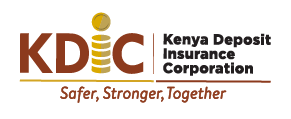
PRESS RELEASE: COMMENCEMENT OF THE RISK-BASED PREMIUM ASSESSMENT MODEL
- The Kenya Deposit Insurance Corporation in partnership with its stakeholders has today rolled out implementation of the highly anticipated Risk-Based Premium Assessment Model.
- Cognizant of the country’s state of economy, this new dispensation in Kenya’s banking sector, is a culmination of three straight years of intense discussions and reviews with the KDIC membership on both the design of the model and its efficacy as well as public participation.
- As such, the primary objective of introducing the Risk-Based Premium System, therefore, is to provide incentives for banks to avoid excessive risk taking.
- Further, this model ensures equity in the premium assessment process in line with the Corporation’s core mandate and compliance with Section 27 of KDIC Act, 2012.
- The Risk Based Premium model will enable the Corporation to differentiate risks among banks and effectively assign premiums for each risk cluster.
- The model utilizes a variety of relevant information provided by the bank to determine its risk category.
- All commercial and microfinance banks, who are members of the deposit insurance, have at individual levels been sensitized on the assessment process of determining risk categories, the premium rates for each category and how a bank could improve its risk profile.
- In order to address any emerging issues, the Risk-Based Premium model will be regularly re-assessed on its effectiveness and efficiency in meeting its objectives. Where it is found, necessary, the model will be up-dated and/or revised to meet changing market conditions or requirements.
Background Information:
Sound funding arrangements are critical for the effectiveness of the deposit insurance system in a country. According to the Financial Stability Board, a deposit insurance system should have diverse funding mechanisms necessary to ensure a prompt reimbursement of depositors’ claims when required to do so.
Funding for deposit insurance can be achieved through loans, levies of premiums, borrowings consolidated fund in the event of a systemic failure, or a combination. KDI Act limits funding of the Deposit Insurance Fund to premium assessment and limited borrowing from the Central Bank. In order to meet this funding obligation, the Corporation adopted an ex-ante flat-rate premium system since its establishment because of its simplicity in design, implemention and the limited mandate.
Although this methodology has the advantage of being relatively easy to understand and administer, it fails to take into considerations the level of risk that a bank poses to the deposit insurance fund and the banking system. The methodology is thus perceived to be inequitable in that the same premium rate is charged to all banks regardless of their risk profile. To enhance equity and market discipline amongst member institutions, many deposit insurers across the world are now adopting the Risk-Based Premium Assessment Model in accordance with international best practice.
For the past three years, the Corporation has been engaging stakeholders on various aspects of this implementation including design of the model, public participation and assessment of the state of the economy and are now ready to implement.
END
Signed on this Wednesday, June 30, 2021 by;
Mr. Mohamud Ahmed Mohamud
CHIEF EXECUTIVE OFFICER.







